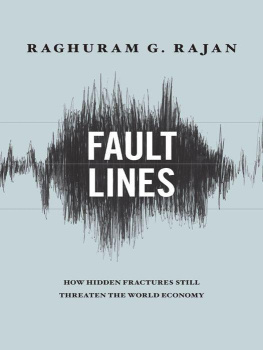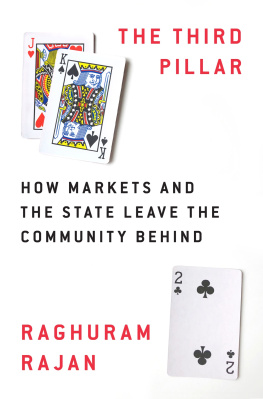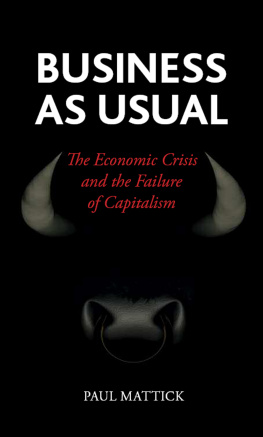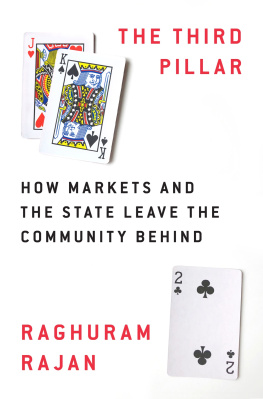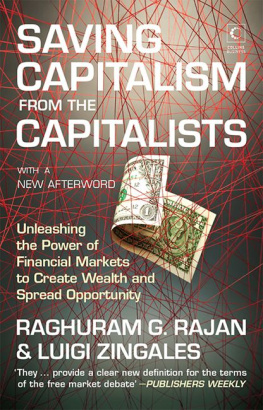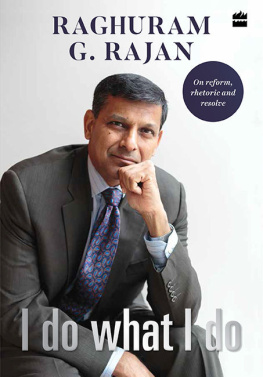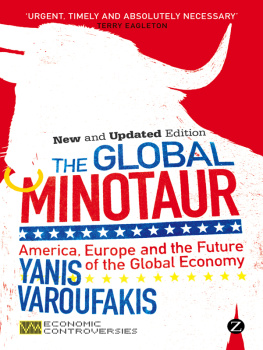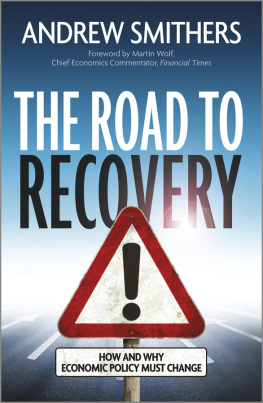

How Hidden Fractures Still
Threaten the World Economy
RAGHURAM G. RAJAN
PRINCETON UNIVERSITY PRESS
Princeton and Oxford
Copyright 2010 by Princeton University Press
Published by Princeton University Press, 41 William Street, Princeton, New Jersey 08540
In the United Kingdom: Princeton University Press, 6 Oxford Street, Woodstock, Oxfordshire
OX20 1TW
press.princeton.edu
All Rights Reserved
Library of Congress Cataloging-in-Publication Data
Rajan, Raghuram.
Fault lines : how hidden fractures still threaten the
world economy / Raghuram G. Rajan.
p. cm.
Includes bibliographical references and index.
ISBN 978-0-691-14683-6 (hardcover : alk. paper)
1. Income distributionUnited StatesHistory21st century.
2. United StatesSocial conditions21st century.
3. Global Financial Crisis, 20082009. 4. Economic history
21st century. I. Title.
HC110.I5R36 2010
330.90511dc22 2010006031
British Library Cataloging-in-Publication Data is available
This book has been composed in Minion Pro and Knockout
by Princeton Editorial Associates Inc., Scottsdale, Arizona.
Printed on acid-free paper.

Printed in the United States of America
1 3 5 7 9 10 8 6 4 2
To my parents
CONTENTS
ACKNOWLEDGMENTS
A BOOK IS ALMOST ALWAYS a collective effort, even if it has only a single author. I owe many of the ideas in this book to the stimulating environment at the University of Chicagos Booth School of Business, where I have spent the best part of my academic life. The work I have coauthored with Douglas Diamond and Luigi Zingales is also central to some of my thinking here. Comments from Anil Kashyap, Richard Posner, Amit Seru, and Amir Sufi were very useful. I owe special thanks to Viral Acharya at New York Universitys Stern School of Business, who gave me very detailed comments on the chapters on finance. I have also benefited greatly from conversations with Marshall Bouton, John Cochrane, Arminio Fraga, Shrinivas Govindarajan, David Johnson, Randall Kroszner, Charles Prince, Edward Snyder, Joyce van Grondelle, Robert Vishny, Martin Wolf, and Naomi Woods. I thank Rishabh Sinha and Swapnil Sinha for their research assistance.The time I spent at the International Monetary Fund between August 2003 and December 2006 taught me a lot about the politics of international finance. I learned a great deal from Anne Krueger and Rodrigo de Rato, as well as from my colleagues in the research department there, especially Timothy Callen, Charles Collyns, Kalpana Kochhar, Paolo Mauro, Gian Maria Milesi-Ferretti, Jonathan Ostry, Eswar Prasad, David Robinson, and Arvind Subramanian. Ken Rogoff, my predecessor at the Fund, has always been generous with his time and has been a source of very useful advice.Seth Ditchik, my editor at Princeton University Press, has been invaluable in shaping my ideas into a coherent book. Peter Dougherty, the director, has been very supportive throughout the process. I also thank the other staff members of Princeton University Press and members of Princeton Editorial Associates who have helped bring the book to publication.This book would not have been written without the support, encouragement, advice, and detailed comments I received from my wife, Radhika. She has been a true partner every step of the way. Finally, I thank my children, Tara and Akhil, for putting up with my workmaybe it was a relief to them because it prevented me from giving their lives my undivided attention. At any rate, they give me two great reasons to try to make the world better for the generations to come.Chicago, February 2010
Introduction
T HE FINANCIAL COLLAPSE of 2007 and the recession that followed left many economists on the defensive. News programs, magazines, pundits, and even the Queen of England all asked some variant of the question, why didnt you see it coming? Some in the economics community wrote articles or convened conferences to examine how they could have gotten it so wrong; others engaged in a full-throated defense of their profession. For many who were hostile to the fundamental assumptions of mainstream economics, the crisis was proof that they had been right all along: the emperor was finally shown to have no clothes. Public confidence in authority was badly shaken.Of course, it is incorrect to say that no one saw this crisis coming. Some hedge fund managers and traders in investment banks put their money instead of their mouths to work. A few government and Federal Reserve officials expressed deep concern. A number of economists, such as Kenneth Rogoff, Nouriel Roubini, Robert Shiller, and William White, repeatedly sounded warnings about the levels of U.S. house prices and household indebtedness. Niall Ferguson, a historian, drew parallels to past booms that ended poorly. The problem was not that no one warned about the dangers; it was that those who benefited from an overheated economywhich included a lot of peoplehad little incentive to listen. Critics were often written off as Cassandras or permabears: predict a downturn long enough, the thinking went, and you would eventually be proved right, much as a broken clock is correct twice a day. I know, because I was one of those Cassandras.Every year, the worlds top central bankers get together for three days at Jackson Hole, Wyoming, along with private-sector analysts, economists, and financial journalists, to debate a set of topical papers commissioned for the event by the host, the Federal Reserve Bank of Kansas City. Following each days presentations, participants go on long hikes in the beautiful Grand Teton National Park, where, amid the stunning mountain scenery, they talk central-banker shop: intense arguments about the Wicksellian rate of interest mingle with the sounds of rushing streams.The 2005 Jackson Hole Conference was to be the last for the Federal Reserve Board chairman, Alan Greenspan, and the theme, therefore, was the legacy of the Greenspan era. I was the chief economist of the International Monetary Fund (IMF) at that time, on leave from the University of Chicago, where I have taught banking and finance for the best part of two decades. I was asked to present a paper on how the financial sector had evolved during Greenspans term.The typical paper on the financial sector at that time described in breathless prose the dramatic expansion of financial markets around the world. It emphasized the wonders of securitization, which allowed a bank to package its risky housing or credit card loans together and sell claims on the package in the financial market. Securitization allowed a bank to get the risky loans off its books. At the same time, it allowed long-term investors in the market, such as pension funds and insurance companies, to take on a small portion of the risky claims that they, by virtue of having longer horizons and holding a diverse portfolio of other assets, could hold more easily than the bank. In theory, with the risk better spread across sturdier shoulders, investors would demand a lower return for holding the risk, allowing the bank to charge lower loan rates and expand borrowers access to finance.In preparation for writing the paper, I had asked my staff to prepare graphs and tables. As we looked through them, I noted a few that seemed curious. They were plots of different measures of the riskiness of large U.S. banks, and they suggested that banks had become, if anything, more exposed to risk over the past decade. This was surprising, for if banks were getting risky loans off their balance sheets by selling them, they should have become safer. I eventually realized that I was committing the economists cardinal sin of assuming ceteris paribus, that is, assuming that everything else but the phenomenon being studied, in this case securitization, remained the same. Typically, everything does not remain the same. Most important, deregulation and developments like securitization had increased competition, which increased the incentives for bankers (and financial managers more generally) to take on more complex forms of risk.Once I saw this trend, the paper quickly wrote itself and was titled Has Financial Development Made the World Riskier? As the Wall Street Journal reported in 2009 in an article on my Jackson Hole presentation:Incentives were horribly skewed in the financial sector, with workers reaping rich rewards for making money but being only lightly penalized for losses, Mr. Rajan argued. That encouraged financial firms to invest in complex products, with potentially big payoffs, which could on occasion fail spectacularly.He pointed to credit default swaps which act as insurance against bond defaults. He said insurers and others were generating big returns selling these swaps with the appearance of taking on little risk, even though the pain could be immense if defaults actually occurred.Mr. Rajan also argued that because banks were holding a portion of the credit securities they created on their books, if those securities ran into trouble, the banking system itself would be at risk. Banks would lose confidence in one another, he said. The interbank market could freeze up, and one could well have a full-blown financial crisis.Two years later, thats essentially what happened.
Next page
